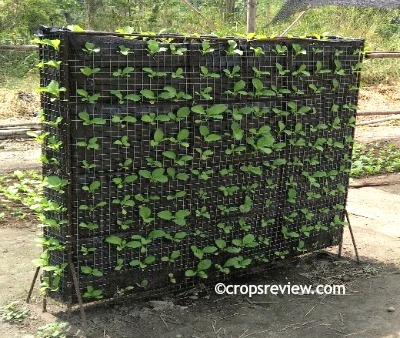Anyone can experiment in creating his own vertical garden or wall garden, subject to financial limitations depending on the chosen design and familiarity with adapted plants.
However, for those who do not enjoy the benefit of time in experimenting and where aesthetics is a consideration, it may be best to seek the help of an expert.

Basic Concepts in Making Such a Vertical Garden
The basic concepts in making such a vertical garden are quite simple
First, a frame to hold a growing medium is attached to the wall, supplied with the necessary support to prevent excessive bulging.
To prevent the medium from spilling or eroding, it is held in place by a barrier on the outside of this frame.
Second, the space between the wall and the outside barrier is filled with a growing medium up to the top.
Third, plants are grown by inserting seedlings or seeds in holes poked into the vertical surface of the garden.
Fourth, the plants are supplied with water from the top, allowing it to percolate downward.
In the February 1982 issue of Sunset magazine, two methods of constructing vertical gardens are outlined.
One consisted of a growing frame made of tubular steel covered with chain link (cyclone wire) fencing.
Verticals were sunk into concrete and the fencing was covered with sphagnum, and the frame was filled with lightweight potting soil.
Care of the garden consisted of watering, fertilizing and spraying, picking of dead flowers, and replacing plants.
Another wall garden was made on a 6- by 12-foot (1.83 m x 3.65 m) wall made of concrete blocks.
A wooden grid was first nailed to the wall and 2-foot-wide (0.61 m) strips of chicken wire were filled with moss.
One strip was stapled to the lowest wood nailer, and the space behind it was filled with soil mix.
The soil mix was watered, allowed to settle, and more mix was added.
The top of the strip was then stapled to the next row of wood blocking.
The process was repeated up to the uppermost level of the wall (Sunset 1982b).
Other materials to hold the soil mix in place have been used instead of moss such as the black polyethylene and black polypropylene shadecloth.
Holes are poked into the covering and plants are inserted.
The chain link and plastic covering, however, may appear unsightly until the plants grow and entirely cover them (Sunset 1982a).
A popular north-facing wall garden is that of the Musée du Quai Branly in France, created by Patrick Blanc as with many more in different locations.
Inspired by the natural scenery consisting of vegetation growing on wet vertical rock surfaces throughout the world, he simulated this on indoor and outdoor walls of urban buildings.
In every square meter of the vertical surface, 10 to 20 plants are grown, mostly tropical species that are tolerant to shade. Plant selection is also based on aesthetic consideration.
To mimic nature, these plants are interspersed on a base of mosses and liverworts.
A drip irrigation system is installed to ensure a continuous supply of dilute fertilizer solution (frenchgardening.com, 2006).
In the Philippines, vertical gardens are of more recent introduction.
During the Agrilink trade show held at the World Trade Center in Metro Manila on October 7-9, 2010, Harbest Agribusiness showed a portable vertical garden mix-planted with culinary herbs such as Taiwan basil, sweet basil, and tarragon.
It consisted of a vertical structure made of poultry wire that is 54 inches (137.16 cm) tall, 24 inches (60.96 cm) wide on two sides, and 6 inches (15.24 cm) on the two narrow sides, framed with steel bars.
It is lined inside with a shade net and black plastic on the outside.
The structure is filled with a growing medium consisting of a mixture of coco peat, carbonized rice hull, and slow-release fertilizer.
Holes were punched on the sides where the seedlings were planted in different layers from the bottom up.
Accordingly, other plants such as lettuce, pechay, and other leafy vegetables can also be planted on a vertical garden (Abello 2010).
REFERENCES
ABELLO MM. 2010. S&T; fair features Mindanao products, technologies. Agriculture Monthly Magazine. November 2010. XIV (II): 58-63.
FRENCHGARDENING.COM. 2006. The vertical garden at the Musée du Quai Branly. Retrieved March 15, 2011 from http://www.frenchgardening.com/visitez.html?pid=1140712820340395.
SUNSET. 1982a. Putting together your own tapestry wall. Sunset. February 1982. p. 197-198.
SUNSET. 1982b. Tapestry walls. Sunset. February 1982. p. 80-81.

